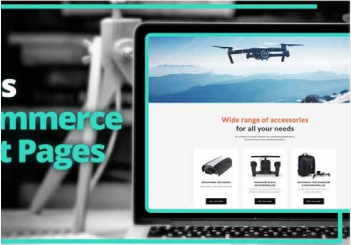How To Prevent Magento To Shopify Migration Pitfalls

6 August 2020 Blog Posts
With Magento 1 support nearly ending (June 2020), we have received an increasing amount of questions around migrating to Shopify and migrating platforms in general. As a platform agnostic agency, we know that the right platform for our clients depends on many internal factors, such as:
While migrating from Magento to Shopify can ease some internal pain points, it can come at an Organic search cost that reverberates across other online channels if not properly managed. Common SEO & E-commerce related costs to factor include:
(Here we can clearly see when the migrations occurred for 2 separate sites – verified through Wayback machine).
As a result of encountering more and more scenarios like this, we have discovered an interesting pattern of Magento to Shopify pitfalls which can be addressed.
This stems from platform capabilities and URL structure related challenges when moving from platforms that use Organic search optimised folder structure URLS, to single level URLS; which in some occasions are virtual folders.
Folder Structure Example:
The significant change in the URL structure breaks the Organic search value chain, this stems from the creation of essentially a virtual folder in the URL. This creates a consistent pattern of initial keyword volatility, traffic and ultimately Organic revenue loss during the adjustment period.
This segment of the URL creates an unnecessary folder level, which never provides value to search engines and will never rank for any relevant terms; nor passes page value to their attached collections. Moving to essentially a single-level structure, detached from what should be one of the most powerful pages in Organic search (Home Page) puts all your category level assets at risk if this is not on your radar. Not to mention the assisting conversions Organic traffic contributes to omnichannel conversion paths.
Avoid these pitfalls before its too late, prepare well in advance and involve your Organic search partner in discussions around choosing platforms and ongoing capabilities in Organic search. This is a proven strategy to mitigate any losses from Organic search at an early stage.
Businesses rely on internal & external partners, to advise and navigate them through the treacherous waters of “migration” and the Organic search challenges that come with it. But what happens to your business, when your partners have not encountered & overcome these e-commerce specific types of challenges before?
This comes in the form of possible mishandled 301’s, crawl budget blowouts, overuse of tags & general sidebar filtering limitations, change in navigation. This can exacerbate the impact of URL changes after migrations. This is not an isolated challenge only common to Magento to Shopify migrations, it is a frequent challenge encountered across WordPress, Neto, Big Commerce and many others.
In our experience, when this is not raised and factored into the decision making process; the average impact we’ve seen is at least a 30%+ loss in keywords, traffic and even more in revenue in some cases.
If Organic is one of the main channels for revenue & assisted conversions across other channels (Paid, Direct, Social, E-mail), the aftermath can reverberate across the whole business. Cash flow challenges arise, warehousing & operating costs remain, marketing budgets tighten and in worst cases, staff layoffs become a harsh reality. Situations like this obviously don’t stem from URL changes alone but incorporate other website related factors.
Having a once performing channel that is now faltering Organic channel causes ongoing challenges. If left unchecked, expenditure on Paid campaigns with higher Cost Per Acquisition Costs increases to fill the void created by the drop in Organic contribution, limiting flexibility in investing in other areas of the business.
We’re not saying that this happens to all sites that migrate, or not to migrate. It is a concerning pattern you can avoid that we’ve encountered, that started from the task of recovering e-commerce websites from failed migrations. It is consistently overlooked when choosing platforms and is emerging as a huge challenge within Organic search & e-commerce.
In the past, we’ve lost projects from being honest and blunt about what could happen, to other agencies that “know Shopify & Magento”; Only for them to come back after failed a migration after huge costs. We’ve taken onboard well known brands that were given expert advice on Magento to Shopify migrations, to only discover that they have had their most valuable pages 301 redirected to a page that canonicals to another.
Plan ahead, deep dive into your analytics and take the time to really understand the platform and its limitations & possibilities in the e-commerce SEO field. Involve specialist partners & not generalists to assist in playing the devil’s advocate for such a move. Really assess which platform will incorporate your e-commerce, SEO & internal business needs by preparing for migration and recovery.
Recovery is definitely possible. There are sites that have recovered, which can range from a minimum 12+ months plus recovery time if left unchecked or 9+ months if action points are properly prepared for.
If the end decision is to still move platforms, even after the risks have been evaluated; preparing your website and business for the possible downturn is the best way out.
I could go on and on about what to look out for when deciding to move from Magento to Shopify or Shopify to Magento. But hitting home the message of researching, involving the right partners and understanding that this must be planned for well in advance and should not be reacted to; will be key to your ongoing success.
Cover the points to mitigate risks:
The benefit of re-platforming either way can be worth it, just make sure that the right partners are involved in key stages and make sure the website and business are prepared for the journey ahead.
What started as a challenge in overcoming single level URL structures, led to a discovery of a pattern that has impacted countless sites which led to the even bigger topic of platform migrations.
The costs of not comprehensively preparing your business and website far outweigh the savings. In the current tough retail environment of voluntary administration and mass layoffs due to underperforming brick and mortar stores, invest in protecting your online channel by being prepared. Don’t become another case study of what not to do, simply to save a few dollars; invest in protecting your online assets.
- Affordability.
- Maintenance Costs.
- Ease Of Use.
- Finding The Right Partners/Agencies.
- Marketing Opportunities.
- Integrations.
- Product Range.
While migrating from Magento to Shopify can ease some internal pain points, it can come at an Organic search cost that reverberates across other online channels if not properly managed. Common SEO & E-commerce related costs to factor include:
- Server Optimisation / Site Speed.
- Potential Loss of Valuable Static Pages.
- Navigation Changes.
- Crawl Budget Blow Out.
- Index Bloat From Tags.
- URL Structure Overhaul.
(Here we can clearly see when the migrations occurred for 2 separate sites – verified through Wayback machine).

1. URL Structure: Where It All Started
One of the key differences between Magento and Shopify revolves around URL structures at the product and category level. This change can create a chain reaction of events that impact omnichannel businesses.As a result of encountering more and more scenarios like this, we have discovered an interesting pattern of Magento to Shopify pitfalls which can be addressed.
This stems from platform capabilities and URL structure related challenges when moving from platforms that use Organic search optimised folder structure URLS, to single level URLS; which in some occasions are virtual folders.
Folder Structure Example:
- /bananas/lady-finger/
- /oranges/valencia/
- /apples/pink-lady/
- /collections/lady-finger-bananas
- /collections/valencia-oranges
- /collections/pink-lady-apples
The significant change in the URL structure breaks the Organic search value chain, this stems from the creation of essentially a virtual folder in the URL. This creates a consistent pattern of initial keyword volatility, traffic and ultimately Organic revenue loss during the adjustment period.
This segment of the URL creates an unnecessary folder level, which never provides value to search engines and will never rank for any relevant terms; nor passes page value to their attached collections. Moving to essentially a single-level structure, detached from what should be one of the most powerful pages in Organic search (Home Page) puts all your category level assets at risk if this is not on your radar. Not to mention the assisting conversions Organic traffic contributes to omnichannel conversion paths.
Avoid these pitfalls before its too late, prepare well in advance and involve your Organic search partner in discussions around choosing platforms and ongoing capabilities in Organic search. This is a proven strategy to mitigate any losses from Organic search at an early stage.
Businesses rely on internal & external partners, to advise and navigate them through the treacherous waters of “migration” and the Organic search challenges that come with it. But what happens to your business, when your partners have not encountered & overcome these e-commerce specific types of challenges before?
2. Impact On E-commerce
Even when you execute Magento to Shopify migration best practices such as:- Metadata & Content Transfer.
- 301 Redirects.
- Site Speed Improvements.
- Link building & Reclamation
- Indexing & Crawling Optimisation
This comes in the form of possible mishandled 301’s, crawl budget blowouts, overuse of tags & general sidebar filtering limitations, change in navigation. This can exacerbate the impact of URL changes after migrations. This is not an isolated challenge only common to Magento to Shopify migrations, it is a frequent challenge encountered across WordPress, Neto, Big Commerce and many others.
In our experience, when this is not raised and factored into the decision making process; the average impact we’ve seen is at least a 30%+ loss in keywords, traffic and even more in revenue in some cases.
If Organic is one of the main channels for revenue & assisted conversions across other channels (Paid, Direct, Social, E-mail), the aftermath can reverberate across the whole business. Cash flow challenges arise, warehousing & operating costs remain, marketing budgets tighten and in worst cases, staff layoffs become a harsh reality. Situations like this obviously don’t stem from URL changes alone but incorporate other website related factors.
Having a once performing channel that is now faltering Organic channel causes ongoing challenges. If left unchecked, expenditure on Paid campaigns with higher Cost Per Acquisition Costs increases to fill the void created by the drop in Organic contribution, limiting flexibility in investing in other areas of the business.
We’re not saying that this happens to all sites that migrate, or not to migrate. It is a concerning pattern you can avoid that we’ve encountered, that started from the task of recovering e-commerce websites from failed migrations. It is consistently overlooked when choosing platforms and is emerging as a huge challenge within Organic search & e-commerce.
In the past, we’ve lost projects from being honest and blunt about what could happen, to other agencies that “know Shopify & Magento”; Only for them to come back after failed a migration after huge costs. We’ve taken onboard well known brands that were given expert advice on Magento to Shopify migrations, to only discover that they have had their most valuable pages 301 redirected to a page that canonicals to another.
Plan ahead, deep dive into your analytics and take the time to really understand the platform and its limitations & possibilities in the e-commerce SEO field. Involve specialist partners & not generalists to assist in playing the devil’s advocate for such a move. Really assess which platform will incorporate your e-commerce, SEO & internal business needs by preparing for migration and recovery.
3. Avoid The Pitfalls: Prepare For Migration & Recovery
There have been very few cases that have successfully executed the move without any negative impact. These are usually websites that do not rely on non branded Organic traffic, but rather rely on their branding or other marketing channels to generate visits and revenue.Recovery is definitely possible. There are sites that have recovered, which can range from a minimum 12+ months plus recovery time if left unchecked or 9+ months if action points are properly prepared for.


If the end decision is to still move platforms, even after the risks have been evaluated; preparing your website and business for the possible downturn is the best way out.
-
- Review your analytics from an all channels view and outline the impact of changing the current navigation will have on the new site. Repeat customers that are used to the navigation will need time to adjust and expect engagement metrics such as bounce rates, pages visited and time-on-site to change.
- Understand the different navigation capabilities which are being limited by moving to a theme/platform that does not allow for sidebar filtering through static URLs and how this impacts your SEO and overall customer experience for desktop and mobile.
- Set aside a budget for recovering your Organic channel, as well as allocate funds for other marketing channels & branding exercises to prop up the likely downturn.
- Identify your branded Organic strength and leverage this to recover your non branded keywords, it is a proven strategy that stimulates recovery after migrating. Unfortunately, this is not a luxury all websites have or is a widely known strategy that is used after migrations; remember to utilise your online brand strengths where you can.
- Most importantly, include specialists in the migration. Organic search is quite a large field, you certainly do not want a content focused Organic search partner to be handling a website migration with hundreds of categories and thousands of products. Engage a partner which specialises in this field with proven case studies of recovering large sites.
4. Migration Take Aways
I could go on and on about what to look out for when deciding to move from Magento to Shopify or Shopify to Magento. But hitting home the message of researching, involving the right partners and understanding that this must be planned for well in advance and should not be reacted to; will be key to your ongoing success.
Cover the points to mitigate risks:
- Involve Your SEO Partner.
- Weigh Up The Platform Trade Offs.
- Dive into Your Analytics.
- Budget For Recovery.
- Prepare Your Website.
- Do Not Rely On One Channel.
- Use Specialists and Not Generalists.
The benefit of re-platforming either way can be worth it, just make sure that the right partners are involved in key stages and make sure the website and business are prepared for the journey ahead.
What started as a challenge in overcoming single level URL structures, led to a discovery of a pattern that has impacted countless sites which led to the even bigger topic of platform migrations.
The costs of not comprehensively preparing your business and website far outweigh the savings. In the current tough retail environment of voluntary administration and mass layoffs due to underperforming brick and mortar stores, invest in protecting your online channel by being prepared. Don’t become another case study of what not to do, simply to save a few dollars; invest in protecting your online assets.



